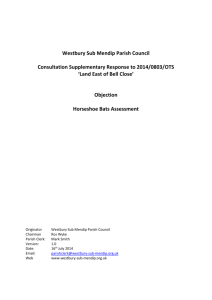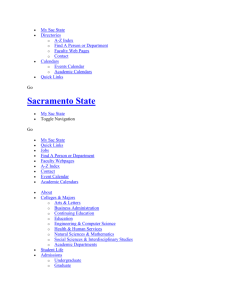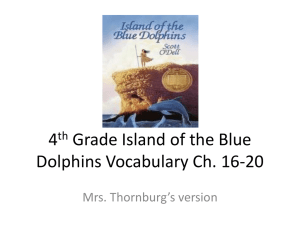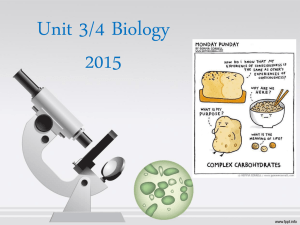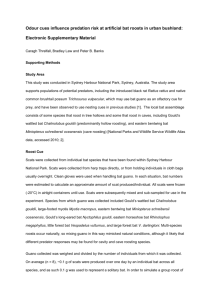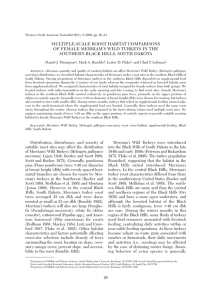Appendix A – Somerset County Council HRA Screening Report Extract
advertisement
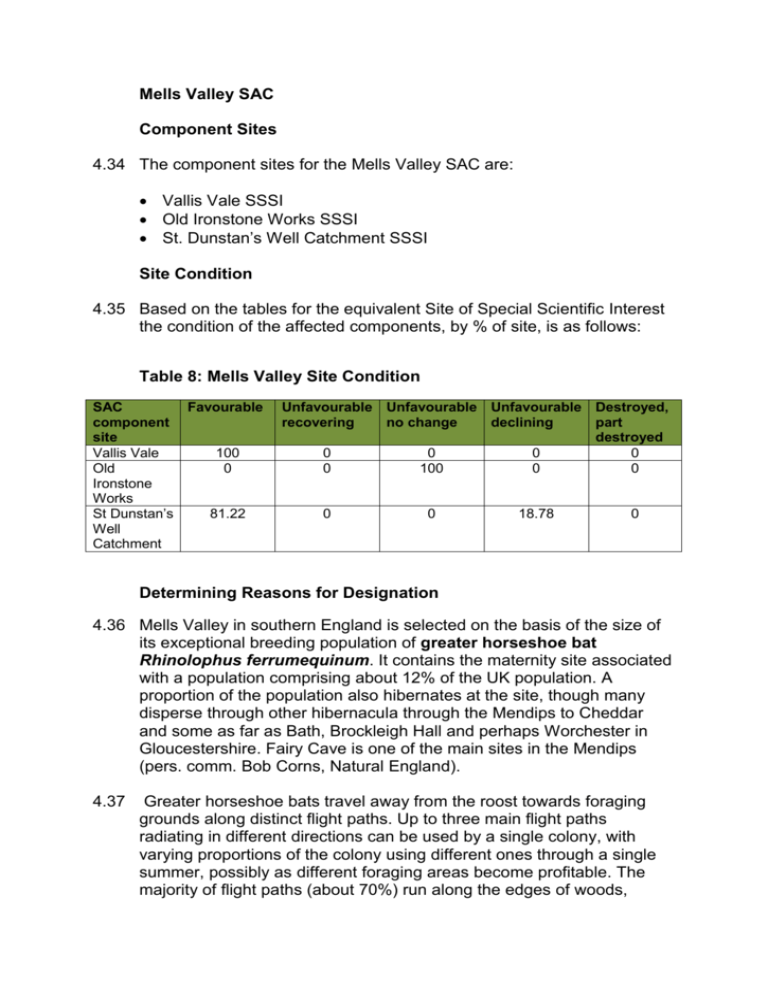
Mells Valley SAC Component Sites 4.34 The component sites for the Mells Valley SAC are: Vallis Vale SSSI Old Ironstone Works SSSI St. Dunstan’s Well Catchment SSSI Site Condition 4.35 Based on the tables for the equivalent Site of Special Scientific Interest the condition of the affected components, by % of site, is as follows: Table 8: Mells Valley Site Condition SAC Favourable component site Vallis Vale 100 Old 0 Ironstone Works St Dunstan’s 81.22 Well Catchment Unfavourable Unfavourable Unfavourable Destroyed, recovering no change declining part destroyed 0 0 0 0 0 100 0 0 0 0 18.78 0 Determining Reasons for Designation 4.36 Mells Valley in southern England is selected on the basis of the size of its exceptional breeding population of greater horseshoe bat Rhinolophus ferrumequinum. It contains the maternity site associated with a population comprising about 12% of the UK population. A proportion of the population also hibernates at the site, though many disperse through other hibernacula through the Mendips to Cheddar and some as far as Bath, Brockleigh Hall and perhaps Worchester in Gloucestershire. Fairy Cave is one of the main sites in the Mendips (pers. comm. Bob Corns, Natural England). 4.37 Greater horseshoe bats travel away from the roost towards foraging grounds along distinct flight paths. Up to three main flight paths radiating in different directions can be used by a single colony, with varying proportions of the colony using different ones through a single summer, possibly as different foraging areas become profitable. The majority of flight paths (about 70%) run along the edges of woods, woodland rides or tall hedges, only rarely crossing open fields. (Ransome, 1996) Greater horseshoes will not cross gaps of greater than15 metres although open fields are crossed after dusk on dark nights (Jones & Billington, 1999; Ransome, 1996). They travel about 1 metre away from vegetation edges. (Ransome, 1996) 4.38 The top five feeding areas include: pasture with cattle as single stock of part of mixed stock (38.6%); ancient semi natural woodland (16.6%); pastures with stock other than cattle (10.3%); meadows grazed by cattle in the autumn (9.4%); and other meadows and broadleaved woodland (4.9%). These habitats are not used according to the fore listed proportions throughout the year but change with the seasons. Woodlands and pasture adjoining wood are used in spring and early summer. As summer progresses, feeding switches to areas further away and tends to be fields used for grazing cattle and other types of stock. Meadows that had been cut and where animals are grazing are also used. (Duvergé & Jones, 1994) 4.39 At Mells a radio tracking study (Billington, 2000a) showed the importance of high overgrown hedgerows, next to meadows and grazed pastures, areas of scrub and tree lines or woodland edges often near water as primary foraging habitat. Bats were shown to be commuting, mostly within 3 kilometres of the roost site and up to 3.5 kilometres from the roost site to Kingsdown Wood, Ammerdown. A route that one male traversed from Wadbury to there was 7 kilometres. (Billington, 2000) Adult bats were happy to commute 6 kilometres to feeding areas but the juveniles stayed within 4 kilometres of the roost (Billington, 2004). 4.40 Current factors considered to be causing loss or decline in greater horseshoe bats include: Loss, destruction or disturbance of roost sites Loss, damage or fragmentation of important foraging habitats and flyways, such as woodland, and connecting linear features such as hedgerows and tree lines and pasture. Lack of suitably connected foraging habitats (a mosaic of pasture hedgerows and woodland) Loss or disruption of key flyways between different roosts 4.41 The conservation objective for the feature is ‘to maintain, in favourable condition, the habitats for the population of Greater horseshoe bat (Rhinolophus ferrumequinum)’. The attributes that measures the condition of the feature are the buildings containing bat maternity and hibernation roosts’ roof covering, entrances, light levels, the degree of disturbance, the general condition and security of building, the internal condition in roost area and signs of bats. 4.42 Caves not open to the public are present on the Vallis Vale and St. Dunstan’s Well Catchment component sites and are selected as features of the SAC as they provide important hibernation sites for greater horseshoe bats. Fairy Cave (part of the St. Dunstan’s Well Catchment component site) is one of the main roost sites in the Mendips. 4.43 The conservation objective for the feature is ‘to maintain, in favourable condition, the caves not open to the public’. The attributes that measures the condition of the feature as hibernation roosts are the state of entrance, the security of the entrance, external conditions, lack of disturbance and use by bats. 4.44 St Dunstan’s Well Catchment component site also hosts an area of Semi-natural dry grasslands and scrubland facies: on calcareous substrates (Festuco-Brometalia). Festuco-Brometalia grasslands are found on thin, well drained, lime-rich soils associated with chalk and limestone. They occur predominantly at low to moderate altitudes in England and Wales, extending locally into upland areas in northern England, Scotland and Northern Ireland. Most of these calcareous grasslands are maintained by grazing. Where grazing levels are reduced, such as at this site, Festuco-Brometalia swards typically become dominated by coarse grasses (in particular, downy oat-grass Avenula pubescens, tor-grass Brachypodium pinnatum and upright brome Bromus erectus), and plants of smaller stature become correspondingly scarcer. CG3 Bromus grassland, CG4 Brachypodium grassland and CG5 Bromus –Brachypodium grassland are present. 4.45 The conservation objective for the feature is ‘to maintain, in favourable condition, the semi-natural dry grasslands and scrubland facies: on calcareous substrates (Festuco-Brometalia)’. The attributes that measure the condition of the feature are the extent of the habitat, the sward composition and the sward structure. Table 9: Mells Valley Key Environmental Conditions Qualifying features Greater horseshoe bat Caves not open to the public Semi-natural dry grasslands and Key environmental conditions to support site integrity Undisturbed roosts Roost conditions maintained Appropriate management of vegetation at roost entrances Maintenance and connectivity of habitats used as flight line on and off site Feeding areas Pressure from human activity above and below ground Management of overlying land and catchment Appropriate management Soil conditions scrubland facies on calcareous substrates Sward structure and composition Absence of negative indicator species Ecological Zone of Influence 4.46 For greater horseshoe bats a buffer of 6 kilometres around the maternity roost site areas are formed. Starting with maternity roosts OS Mastermap polygons of connected habitat within home range is digitised. This process is further analysed using aerial photographic interpretation and available habitat data. Identification of flyways and feeding areas are also based on radio tracking data produced in 2000 for the Mells Valley SAC (Billington, 2000a). This forms the EZI for greater horseshoe bats, which is shown in Map 4. 4.47 The unimproved calcareous grasslands are sensitive to changes in air quality. The habitat therefore may be influenced outside the SAC by dust and air pollution resulting from issues set out in Chapter 3. Air pollution from traffic may have eutrophication effects, which would impact on species composition in the sward. Map 4: Mells Valley SAC Ecological Zone of Influence 4.48 Two hundred metres is the distance from a road where nitrogen deposition is expected to occur in the Habitat Regulations Assessment of the draft Regional Spatial Strategy for the South West (2006). Bignell et al, (2004) consider that 150 metres air quality returns to background levels. The greater distance is used, as a precautionary approach is required. Vulnerability 4.49 The bat population in the Mells Valley uses a range of natural caves and manmade tunnels in which to breed and hibernate. None of the sites are currently managed directly for bats. The population is vulnerable to disturbance from human access. Public access and disturbance is having a negative impact on the site. Natural England is discussing access provisions with the owner. 4.50 For the unimproved grassland cutting or grazing, including control of scrub encroachment maintains the sward. The presence of negative indicator species may indicate problems such as eutrophication, scrub invasion (insufficient control) or over grazing (e.g. by rabbits). A suitable grazing regime is required. Mendip Woodlands SAC Component Sites 4.51 The component sites for the Mendip Woodlands SAC are: Asham Wood SSSI Ebbor Gorge SSSI Rodney Stoke SSSI Cheddar Wood SSSI Site Condition 4.52 Based on the table for the equivalent Site of Special Scientific Interest the condition of the affected components, by % of site, is as follows: Table 10: Mendip Woodlands Site Condition SAC component site Asham Wood Ebbor Gorge Rodney Stoke Cheddar Wood Favourable 100 Unfavourable Unfavourable Unfavourable Destroyed, recovering no change declining part destroyed 0 0 0 0 80.22 19.78 0 0 0 73.59 10.87 0 15.54 0 6.7 90.09 0 3.21 0

